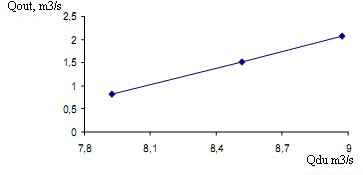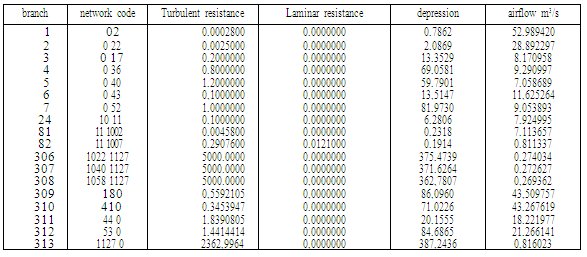To increase the reliability and safety of workers in the mine was developed an algorithm for calculating the air in the mine.
The internal structure of the software product algorithm is designed in a way so that regardless of the law of air motion in a formulation or a group of workings, makes us able to calculate the air distribution in the mine ventilation system. Another its indispensible advantage is in the possibility of processing large streams of information, the amount of which is restricted directly to technical abilities PC-backed being used.
Those qualities allowed us to approach the solution to a both complex and interesting problem - the joint calculation of the distribution of gas-air mixture in the mine ventilation system with the inclusion of model aerodynamics of mine openings adjacent to mining sites (with the regards for adjacent to them pillars), with the inclusion into a model of additional sources of thrust ventilation and decontamination systems. Thus, it is possible to analyze and evaluate the complex of ventilation and mine drainage systems, manage and regulate of mass transfer processes occurring in the openings of the production units.
To conduct research in this direction together with specialists from the Scientific and Engineering Center of mine rescuers of Kazakhstan Republic, a demonstration test case of mine ventilation system was developed.
The network has a rather complicated structure, the organization of which is close to a functioning ventilation system of mine, and include 85 branches, 4 fans of the main ventilation, 2 mining areas, 7 bares supplying air and air-separating tanks. Picture 1 shows the estimated design diagram topological scheme "test case" with the numbers of units, placing of ventilation, ventilating constructions, regulators and the fans of the main ventilation.
Basing on the example, a series of practical calculations was carried out, in which the structure of the model is successively more complicated, by connecting new additional elements to a basic scheme.
The first calculation, which should be considered as a basic, is the result of natural air distribution in the mine ventilation system with a given topology, invariable aerodynamic parameters of the workings and characteristics of the main ventilation fans. Upon completion of works the calculation results are presented in tabular form, in a format suitable for analysis, in which topological code, aerodynamic characteristics, the air flow through it and depression is represented in front of each branch. Table 1 presents the calculation results of the most important elements of the ventilation network, trunks supplying air, the quantity of air flow on a mine site.
The second step of the research is the calculation of joint air distribution in the mine ventilation systems and adjacent to one of the mine production units (branch 11-12 in the mine ventilation systems) in the open area. This phase has been carried out to determine the impact of open areas’ aerodynamics of a production face on mine ventilation systems to work as a whole.
For this purpose the method of quasimodel of aerodynamics of open area was established. The source data, which has formed the basis for modeling the open area, is given in table 1.
Next, a unified model was formed, including mine ventilation system and net domain, covering the open area. For clarity and convenience of the calculation results analysis the topological code of open area branches and branches, simulating the production unit begin with thousands (i.e. 1001, 1002 and so on).
Collected in this way, the system significantly differs from the basic version of both, internal topological structure and aerodynamics.
The number of branches increased from 85 to 309, along with it aerodynamics of the 225 added items is of a more complicated description. The results of the joint air distribution are presented in Table 3.
Comparative analysis of the results, as expected, showed that the presence of additionally modeled aerodynamic links influenced the air distribution in mine ventilation systems.
In general, the direction of air motion in open areas have remained the same, but the magnitude of the airflow in open areas and running regime of air consumption changed somewhat. Considering the production unit in question, the magnitude of the air flow decreased from 8,76 to 7,23 m³/s, by the very unit to a value of 6,52 m³/s.
The third and the final stage in the empirical study we have carried out is the consideration of additional sources of decontamination system draw with varying capacity, which was performed by adding a model of the new elements - the vertical decontamination wells, connected with a pipeline with the vacuum pump station.
The model included 3 vertical decontamination wells (branch numbers are 306, 307, and 308) drilled from the surface to an open area, consistently placed into the interior of the open area mined within 60 meters from each other.
Thus, considering the joint operation of the ventilation and decontamination systems, we have the opportunity to obtain a more complete and refined picture of mass transfer processes occurring in the mine ventilation system.
As seen from the results, plug the SPA through vertical decontamination holes formed in the previous models, that is regular and also changes the overall picture and the air distribution in mine ventilation systems, and developed a leakage in the open area.
Characteristics of the mine ventilation systems in all cases, the third stage remained practically unchanged. Thus, considering the joint operation of the ventilation and decontamination systems, we have the opportunity to obtain a more complete and refined picture of mass transfer processes occurring in the mine ventilation system. The calculations results are presented in table 1.
As seen from the results, plug the SPA through vertical decontamination holes formed in the previous models, that is regular and also changes the overall picture and the air distribution in mine ventilation systems, and developed a leakage in the open area.
Picture 1 graphically presents the changes of air flow, coming into the production unit (Qdu), depending on changes in the productivity of SPA (Qout). As can be seen from the graph, under the natural air distribution the quantity of air flow at the unit is in direct proportion to the work of the SPA, as only through this branch the connection with mine ventilation system is carried out.

Picture 1. Graph of change in air flow at the production unit, depending on the performance of mine ventilation systems
It should be noted that the work of ventilation systems influenced the airflow in bores, supplying air, and even more on the trunks, located in close proximity to the production unit (branch 0-2, 0-22). As can be seen from a series of practical calculations, the value of airflow at both the production unit, and on other objects of mine ventilation system each time had different values. Maintaining the required air to ventilate the objects can be achieved only with the solution to the problem of forced air distribution.
Table 1 — Calculated values of joint air distribution in the mine ventilation systems, open areas with an expenditure 0,82 m 3/s.

Availability of information about natural methane carrying seam, gas release from the developed layer, the residual methane carrying coal allows to model and include in the design scheme the source of gassing nicks in the open area and the work of predrainage, and thereby take into account their impact in the overall gas balance of the bock.
Conclusions:
1. Joint simulation of mine ventilation systems and open areas allows us to determine the necessary parameters and control the process of mass transfer in coal mines with regard to all active branches and, ultimately, prevent the occurrence of fire and explosions.
2. Designed to solve the backside software "air distribution in the mine ventilation system," at an object-oriented language Visual Basic - allows the calculations for the 10000 or more objects (branches) of mine ventilation system, which is an important and necessary tool for the research.
